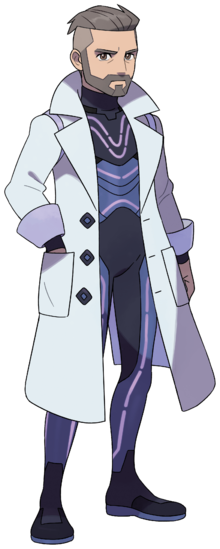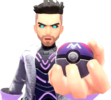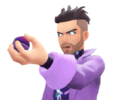From Bulbapedia, the community-driven Pokémon encyclopedia.
Professor Turo
フトゥー Futu
|

Art from Pokémon Violet
|
| Gender
|
Male
|
| Eye color
|
Brown
|
| Hair color
|
Light brown
|
| Hometown
|
Unknown
|
| Region
|
Paldea
|
| Relatives
|
Arven (son)
|
| Generation
|
IX
|
| Games
|
Violet
|
Professor Turo (Japanese: フトゥー Futu) is a Pokémon Professor in Pokémon Violet. His counterpart in Pokémon Scarlet is Professor Sada.
In the core series games
Before the events of Pokémon Violet, Professor Turo was part of the team that explored the Great Crater of Paldea, setting up the Zero Lab in Area Zero. There, Turo discovered and named the Terastal phenomenon. Turo was able to develop a prototype for the Tera Orb, earning him corporate backing for his projects and allowing him to set up a second laboratory in a lighthouse near Cabo Poco. Furthermore, he was able to harness more of the unstable energy, despite concern from his funders, and moved the majority of his research back to the Zero Lab. Turo, fascinated with the idea of Pokémon from other ages, succeeded in developing a time machine that would allow him to reach out to Paradox Pokémon, Pokémon from the distant future, by transporting Poké Balls to different points on the timeline to catch them and bring them into modern time. These included Miraidon, a futuristic descendant of Cyclizar. Additionally, a former associate of Turo had begun expecting his child.
However, Turo began to become obsessed with his research, continuing the influx of Paradox Pokémon into the modern day in his pursuit of a paradise for his family. Shortly after Arven was born, Turo was left without help, driving him deeper into his work and ironically causing him to begin neglecting the very people he had made plans for. Arven ended up growing up in the lighthouse laboratory on Poco Path on his own, never seeing or connecting with Turo due to the latter's newfound devotion to the Tera Project. This estrangement was intensified by Turo's search for a more suitable assistant, leading to him creating an artificial intelligence copy of himself using the Zero Lab's crystals to double productivity. Together, they were able to transport a second, more aggressive Miraidon to the present day, in hopes that the two Miraidon could survive and thrive in their new surroundings. At some point, Turo also developed the Poké Ball Lock System, an ID-based defense mechanism for his lab.
Turo was determined to maintain his dream of present and future Pokémon existing in harmony. Unfortunately, Turo's research was cut short when he attempted to stop a territorial battle between the two Miraidon, defending the passive one and taking a mortal blow from the aggressive one. This also led to the destruction of Research Station No. 4, and Turo eventually passed away, leaving his AI to manage the remnants of his work in his place. However, the AI did not agree with accepting the ecological consequences of Turo's dream, and began impersonating him, reaching out to Turo's associates in hopes of finding a way to end the Tera Project once and for all.
Path of Legends
The AI first contacts the player when they enter the Uva Academy for the first time, impersonating Turo and asking them to take care of the Miraidon that was once under his possession. Throughout the game, the AI frequently contacts the player as Miraidon gradually regains the powers it once lost. Once Miraidon is fully powered, the AI asks the player to travel to Turo's laboratory at the Great Crater of Paldea. As the player, Nemona, Arven, and Penny traverse the area to reach Turo's laboratory, they discover the history of the two Miraidon and Turo's time machine in notebooks left behind in each research station.
The Way Home
At the Zero Lab, the AI reveals its nature to the player and the fate that befell its creator. While the original Turo wished to let Pokémon of the future keep entering the modern day through the time machine, the AI refuses to let the Paldea region's ecosystem be ruined by these time-displaced Pokémon and asks for the player's help in shutting down the time machine. The AI is, however, programmed to protect the time machine, so the player is forced to battle it and the Paradox Pokémon it wields against the AI's will.
After the AI is defeated, the security system initiates the Paradise Protection Protocol, sends out the AI's Miraidon, and activates the Poké Ball Lock System, preventing the player from using any of their Pokémon due to lacking Turo's ID. Thus, the player uses their Miraidon, whose Poké Ball has Turo's ID associated, to battle against the AI's Miraidon. Once the Paradise Protection Protocol has been defeated, the AI understands that the time machine cannot be shut down as long as it remains present to reboot the system, so it chooses to travel to the distant future its creator had hoped to see, bidding farewell to the player and their friends as it disappears into the time machine.
Pokémon
AI Turo's Pokémon are contained in Master Balls.
First battle
Second battle
Formerly owned
Quotes
- Main article: Professor Turo/Quotes
Artwork
Trivia
- Professor Turo was designed by James Turner.[1]
- He and Professor Sada are the first Pokémon Professors from the core series:
- To not have a name derived from flora.
- To have been confirmed deceased.
- They are also the first Trainers in the core series to be battled post-mortem, via an AI, as well as the only non-human antagonists in the core series not to be Pokémon.
- To serve as the final main game opponent in a core series game.
- Unlike previous Trainer battles in which the opponent battles the player with more than six Pokémon, the player also uses a seventh Pokémon against AI Turo. This is also the case when battling his counterpart AI Sada.
Names
| Language
|
Name
|
Origin
|
| Japanese
|
フトゥー Futu
|
From futūrum (Latin for future)
|
English, Spanish,
Portuguese
|
Turo
|
From futuro (Spanish and Portuguese for future)
|
| German
|
Futurus
|
From futūrus (Latin for "about to be")
|
| French, Italian
|
Turum
|
From futūrum (Latin for future)
|
| Korean
|
투로 Turo
|
Transcription of his English name
|
| Chinese (Mandarin)
|
弗圖 / 弗图 Fútú
|
Transcription of his Japanese name
|
| Chinese (Cantonese)
|
弗圖 Fāttòuh
|
Mandarin-based transcription of his Japanese name
|
References










